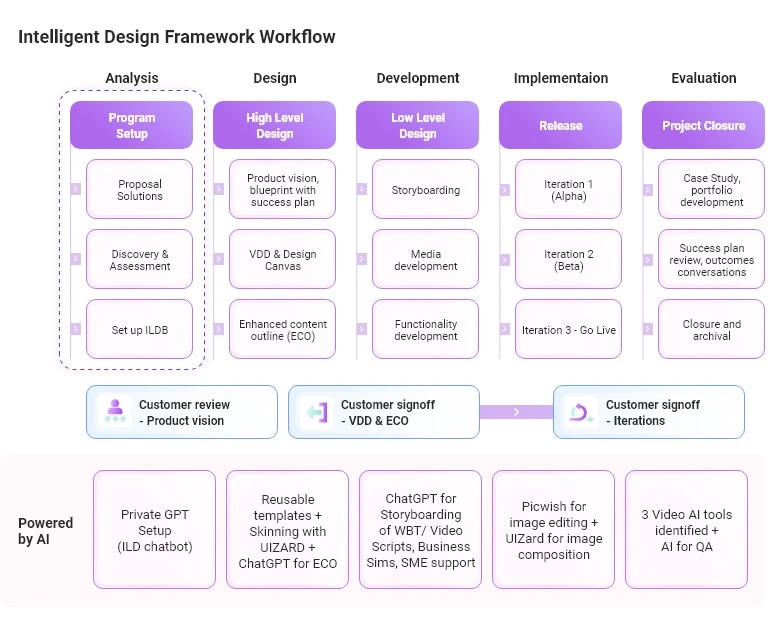Generative AI is more than a buzzword or a fleeting technological trend. It is a profound paradigm shift reminiscent of the transformative impact of the internet and mobile phones. Its potential is boundless, with the capability to revolutionize multiple industries, including ours. Josh Bersin predicts AI will enhance approximately 8% of jobs while generating new roles to leverage its capabilities. The field of learning and development is on the precipice of significant transformation due to the rapid growth of AI technology.
At Infopro Learning, we have strategically reassessed our ways of working to take advantage of all this impending transformation might have to offer. We are in the early stages of exploring, adapting, and conducting initial trials and prototypes on how we can leverage AI in content development for our clients.
Our CEO, Sriraj Mallick, is leading the charge in embracing AI within our organization. Tune in to the webinar replay titled ‘Unlock the Potential of AI to Meet Learning Objectives and Drive Business Outcomes’ from Training Industry: Leader Talks. During this session, he provides a valuable roadmap for L&D leaders and professionals eager to integrate AI technology seamlessly into their day-to-day functions.
From Automation to Generative AI: Shaping the Future
While Generative AI has become a rapidly increasing part of everyone’s lives in recent months, AI has been gradually moving into the mainstream for the past decade. Over this time, there was a significant shift towards automating and standardizing processes previously done by humans. With the introduction of machine learning (ML), technology gained the ability to analyze data, identify patterns, and provide valuable insights, leading to a focus on improving human decision-making.
As deep learning continued to grow, artificial intelligence models developed advanced perceptual skills like computer vision and voice recognition. This strengthened the connection between humans and AI, enabling enhanced interactions and solutions to complex challenges, exemplified by products like Google Home. Finally, Generative AI became pivotal as deep learning technologies and neural networks advanced.
A noteworthy and intriguing fact pertains to OpenAI’s ChatGPT, which garnered 100 million users within a mere month of its launch. In contrast, it took Instagram a span of 30 months to achieve the same milestone of 100 million users. This disparity highlights the tremendous interest generated by Generative AI capabilities and how people leverage them.
Generative AI & Other AI Models for Learning and Development Industry
Generative AI capabilities are also employed within the L&D industry. L&D organizations are harnessing AI capabilities for content creation, course materials development, and assessments and quizzes generation, to name a few use cases. The tools on the right-hand side of the diagram below can assist L&D leaders in identifying suitable tools and use cases for their organizations.
At Infopro Learning, most of our media and user experience teams have begun utilizing tools such as DALL-E2 and Midjourney for prompt-based visual design. They swiftly create prototypes and final design components within the realm of learning. These tools also find applications in simulating learning environments, gamification, adaptive learning, and enhancing accessibility through assistive technologies.

Numerous organizations are adopting these use cases and customizing the tools listed on the right-hand side of the above diagram. They apply them to their unique contexts with varying degrees of success. We, too, have collaborated with some early adopters among our customers to examine the entire learning content life cycle. We have also explored specific use cases akin to targeted solutions, such as AI-driven learning, learning analytics and business outcomes.
Leveraging AI to Create High-Impact Training Content: ADDIE and Intelligent Design Framework
According to a report by Gartner, by 2025, Generative AI will constitute 10% of the total data generated, marking a significant increase from its less than 1% share in 2021.
You might have heard of the ADDIE model, which is a framework for developing training content, like lessons and courses. The ADDIE model has five stages: First, you figure out what you need (Analysis), then you plan how it will look (Design), you make it (Development), then you use it (Implementation), and finally, you see if it worked (Evaluation).
Infopro Learning’s Intelligent Design Framework can be aligned with the ADDIE model. Notably, every stage and phase within the ADDIE model is bolstered by AI.

- To initiate this process, we construct a private GPT instance.
- We ensure that our client’s documents and inputs are stored in a secure, private repository in an Azure private cloud.
Key Features of Intelligent Design Framework
- Data Privacy and Security: Ensures data privacy and security through a private Azure cloud setup for a specific client.
- Client-Specific Content Storage: Generates relevant and customized content for clients from the Azure cloud set up specifically for them.
- Input-Output Processing: Processes input and generates output within the private Azure cloud without storing data in the public domain.
- Intelligent and Context-Aware Responses: Provides intelligent and context-aware responses to user prompts using the ChatGPT engine.
- Customizable Language and Tone: Generates content that aligns with the client’s writing standards and guidelines.
Conclusion
Generative AI is not just a buzzword; it’s a catalyst for high-impact training content and business success. It represents a profound paradigm shift with limitless potential. We embrace this technology to empower clients while ensuring safety and security. The Intelligent Design Framework integrates AI into the ADDIE model, ensuring scalability, adaptability, data privacy, and intelligent responses. The future is promising for those embracing this transformative journey.





